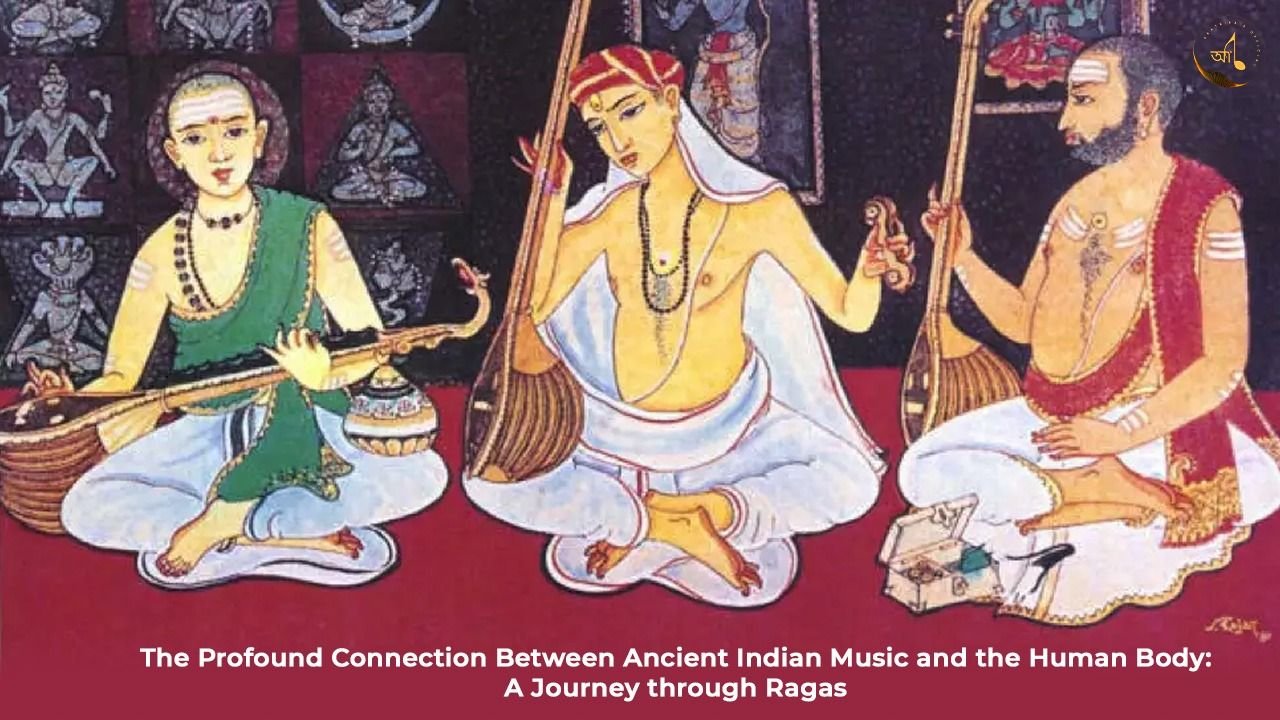Ancient Indian music is not just an art form; it is a spiritual journey that resonates deeply with the human body and mind. The intricate relationship between the notes of a raga and the various aspects of human physiology and psychology has been emphasized by scholars, sages, and musicians for centuries. The Indian classical music tradition, rich with its emphasis on ragas, has always held that music is a powerful tool that can influence and harmonize the mind, body, and spirit.
The Concept of Ragas and Their Emotional Impact
A raga in Indian music is a melodic framework for improvisation akin to a mode or scale in Western music. Each raga has its unique structure, mood, and emotional expression. The ancient texts on Indian music, like the Natya Shastra by Bharata Muni and the Sangita Ratnakara by Sharngadeva, have detailed descriptions of various ragas and their intended effects on the listener.
For instance, Raga Bhairav, often sung in the early morning, is said to evoke feelings of devotion, calmness, and introspection. The deep, sombre notes of this raga are believed to influence the mind's tranquillity, resonating with the body's internal rhythms at the start of the day. On the other hand, Raga Yaman, performed in the evening, is associated with the emotion of shringar (love or beauty) and is said to invoke a sense of peace and devotion as one transitions from the day's activities to the stillness of the night.
Ragas and the Chakras: The Body's Energy Centers
The connection between ragas and the human body is often explored through the lens of the chakras, the energy centres that exist within the body according to ancient Indian spiritual traditions. Each chakra is associated with specific physical, emotional, and spiritual functions, and certain ragas are believed to have the power to influence these energy centres.
For example, Raga Darbari Kanada is linked with the Manipura chakra, located in the solar plexus. This raga, with its deep and serious tone, is believed to resonate with the energy of power, self-confidence, and transformation that this chakra governs. Singing or listening to Darbari Kanada can stimulate this chakra, helping to balance emotions and improve one’s sense of self-worth.
Similarly, Raga Bageshree is connected with the Anahata chakra, or the heart chakra, which is the center of love and compassion. This raga, known for its soft, melodious nature, is said to open the heart, promoting feelings of love, empathy, and emotional healing. When performed with the right intention and understanding, Bageshree can be a powerful tool for overcoming grief, sorrow, and emotional blockages.
Scientific Evidence Supporting the Raga-Body Connection
Modern science has started to explore the physiological effects of music on the body, and while much of this research is still in its infancy, the findings are promising. Studies have shown that listening to specific ragas can reduce stress levels, lower blood pressure, and even alleviate symptoms of depression and anxiety.
For instance, a study conducted by the Department of Neurosciences at NIMHANS (National Institute of Mental Health and Neurosciences) in Bangalore found that Raga Ahir Bhairav had a significant calming effect on patients with hypertension. The slow, deliberate notes of this raga helped in reducing the heart rate and stabilizing the blood pressure, showcasing the profound impact that music can have on the body's autonomic functions.
Similarly, another study published in the Indian Journal of Psychiatry highlighted the benefits of Raga Shankarabharanam in reducing symptoms of anxiety and promoting a sense of well-being among patients with clinical depression. The uplifting and expansive nature of this raga is thought to stimulate the Sahasrara chakra, or the crown chakra, leading to a heightened state of awareness and spiritual connection.
The Holistic Approach to Healing with Ragas
The holistic approach of ancient Indian music treats the body as an interconnected system where the mind, body, and spirit are inextricably linked. Ragas, with their deep emotional and physiological impact, offer a unique way of harmonizing this system. Whether it's through daily practice, therapeutic listening, or meditation, the incorporation of ragas into one’s life can lead to profound physical and emotional healing.
In conclusion, the ancient wisdom embedded in Indian classical music, particularly through the use of ragas, offers a pathway to connect deeply with our own bodies. The deliberate and mindful engagement with this music can help us tune into the natural rhythms of life, balance our energy centres, and ultimately achieve a state of harmony and well-being. The enduring legacy of ragas is not just in their beauty but in their ability to heal and transform us from within.

Leave a reply
The Spiritual and Musical Essence of Maha Kumbh
2025-02-12 12:06:12
How Netaji Subhas Chandra Bose Inspired Generations of India
2025-01-22 11:15:55
Winter Delights: How Bengalis of West Bengal Celebrate the Season with Food, Music, and Picnics
2025-01-08 12:14:19
Ustad Zakir Hussain: A Rhythmic Legacy
2024-12-18 10:53:00
The Sarod: A Pillar of Indian Classical Music
2024-12-11 12:47:47
Hidden Treasures: Lesser-Known Indian Tracks Worth Your Time
2024-12-04 12:18:21